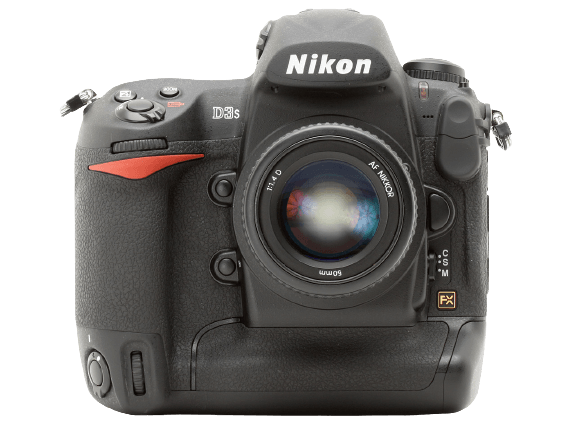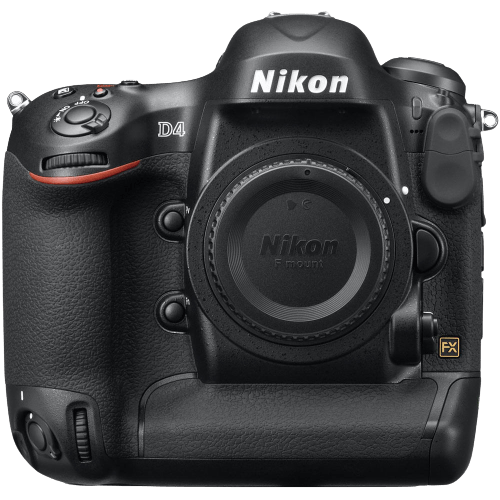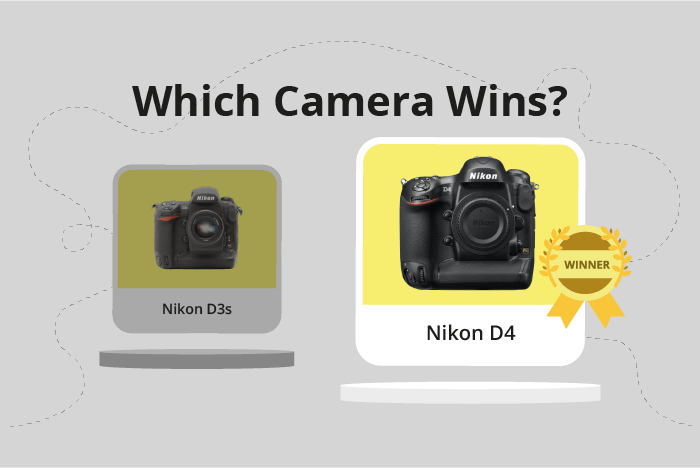Nikon D3s vs D4 Comparison
Nikon D3s

Nikon D4

The Nikon D4 outperforms the Nikon D3s with a score of 63/100 compared to the D3s’s 57/100. Both cameras are DSLR models, released in 2012 and 2009 respectively, with the D4 having a launch price of $5999 and the D3s at $5510. They share similar dimensions, with the D4 being slightly heavier at 1340g, compared to the D3s’s 1240g.
The Nikon D4’s higher score reflects its overall better performance and features. However, the Nikon D3s, despite its lower score, has some advantages, such as being lighter in weight. This could be beneficial for photographers who prioritize portability and ease of use.
Taking into account their scores and specifications, the Nikon D4 stands as the superior camera, offering improved performance and features. The Nikon D3s, on the other hand, provides a more lightweight option for those who value portability.
Nikon D3s vs D4 Overview and Optics
The Nikon D4 outperforms the Nikon D3s in optics, scoring 63/100 compared to the D3s’s 55/100. Both cameras share several specifications, including an 11 frames-per-second shooting speed, a CMOS sensor, a full-frame sensor size, a Nikon F lens mount, and no image stabilization.
The D4’s higher score is due to its superior megapixels and processor. With 16.2 megapixels, the D4 captures more detail than the D3s, which has 12.1 megapixels. The D4 also features the Expeed 3 processor, an improvement over the D3s’s Expeed processor. This contributes to better image quality and faster processing. Additionally, the D4’s sensor has a higher DXOMARK score of 89, while the D3s’s sensor scores 82.
Despite its lower score, the D3s has a slight advantage in low-light situations. Its fewer megapixels allow for larger individual pixels, which capture more light and reduce noise. This makes the D3s a viable option for photographers who prioritize low-light shooting.
Comparing the optics of the Nikon D3s and D4, it is evident that the D4 offers better overall image quality due to its higher megapixel count and improved processor. However, the D3s remains a strong contender for low-light photography. Ultimately, photographers should consider their specific needs and preferences when deciding between these two cameras.
Nikon D3s vs D4 Video Performance
When comparing the video capabilities of the Nikon D3s and the Nikon D4, it is important to note that the Nikon D3s does not have any video functionality. Therefore, the focus of this comparison will be on the video capabilities of the Nikon D4.
The Nikon D4 has a video score of 57 out of 100, which is a solid score for a camera with video functionality. It is capable of recording Full HD video with a maximum resolution of 1920 x 1080 pixels. This high resolution ensures that the videos captured are of good quality and suitable for various purposes. Additionally, the Nikon D4 has a maximum video frame rate of 30 frames per second (fps), which allows for smooth video playback and is a standard frame rate for most video content.
A notable feature of the Nikon D4’s video capabilities is its built-in time-lapse functionality. This feature enables users to create stunning time-lapse videos by capturing a series of images at specific intervals and then combining them into a single video. This can be particularly useful for documenting events or capturing the beauty of nature over a period of time.
To sum up, the Nikon D4 offers solid video capabilities with Full HD resolution, a maximum frame rate of 30fps, and built-in time-lapse functionality. While the Nikon D3s does not have any video functionality, the Nikon D4 provides users with the tools to capture high-quality videos for various purposes.
Nikon D3s vs D4 Features and Benefits
The Nikon D4 triumphs over the Nikon D3s with a feature score of 57/100, while the latter scores 54/100. Despite this difference, both cameras share several specifications, including screen resolution (921,000 dots), lack of touchscreen, flip screen, GPS, WIFI, and Bluetooth capabilities. Nevertheless, the Nikon D4’s higher score reveals its superiority in certain areas, which we will discuss further.
The winning camera, Nikon D4, boasts a larger screen size of 3.2 inches compared to the Nikon D3s’s 3-inch screen. This larger screen provides photographers with a more comfortable and precise viewing experience while composing and reviewing images. It is a notable advantage that contributes to the Nikon D4’s higher feature score.
On the other hand, the Nikon D3s does not surpass the Nikon D4 in any significant aspect. Both cameras lack modern features such as touchscreens, flip screens, GPS, WIFI, and Bluetooth. These missing features limit their overall appeal and utility, but the D3s does not offer any additional advantages over the D4.
Taking into account the shared specifications and the larger screen size of the Nikon D4, it is evident that the Nikon D4 is the superior camera in terms of features. However, both cameras could benefit from incorporating modern features to enhance their functionality and appeal to a broader range of photographers. The Nikon D3s, though slightly inferior to the D4, still offers a decent set of features, but potential buyers should consider the advantages of the Nikon D4’s larger screen size before making a decision.
Nikon D3s vs D4 Storage and Battery
The Nikon D3s and Nikon D4 both score 87/100 in storage and battery. They share similarities, such as having two memory card slots and lacking USB charging capabilities. The D3s accepts CompactFlash (Type I) and UDMA cards, while the D4 is compatible with Compact Flash and XQD cards.
The Nikon D3s outperforms the D4 in battery life, providing 4200 shots per charge, using the EN-EL4a battery type. This is 1600 more shots than the D4, which has a battery life of 2600 shots with its EN-EL18 battery. The D3s is advantageous for photographers who require longer shooting sessions without needing to change batteries.
On the other hand, the D4 offers more versatility in memory card options, allowing users to choose between Compact Flash and the faster XQD cards. This may be beneficial for photographers who prioritize higher storage capacities and faster transfer speeds.
Therefore, the Nikon D3s is superior in terms of battery life, while the Nikon D4 provides more flexibility in memory card choices. Both cameras offer reliable storage and battery performance, catering to different user preferences.
Nikon D3s vs D4 – Our Verdict
Are you still undecided about which camera is right for you? Have a look at these popular comparisons that feature the Nikon D3s or the Nikon D4:

